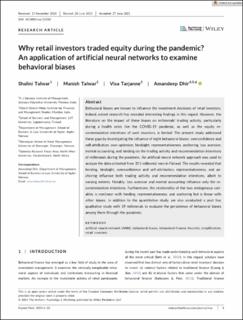| dc.contributor.author | Talwar, Shalini | |
| dc.contributor.author | Talwar, Manish | |
| dc.contributor.author | Tarjanne, Visa | |
| dc.contributor.author | Dhir, Amandeep | |
| dc.date.accessioned | 2021-10-21T13:33:59Z | |
| dc.date.available | 2021-10-21T13:33:59Z | |
| dc.date.created | 2021-08-11T12:59:11Z | |
| dc.date.issued | 2021-07 | |
| dc.identifier.citation | Talwar, S., Talwar, M., Tarjanne, V., Dhir, A. (2021) Why retail investors traded equity during the pandemic? An application of artificial neural networks to examine behavioral biases. Psychology & Marketing, 38(11), 1-22. | en_US |
| dc.identifier.issn | 0742-6046 | |
| dc.identifier.uri | https://hdl.handle.net/11250/2824564 | |
| dc.description.abstract | Behavioral biases are known to influence the investment decisions of retail investors. Indeed, extant research has revealed interesting findings in this regard. However, the literature on the impact of these biases on millennials' trading activity, particularly during a health crisis like the COVID-19 pandemic, as well as the equity recommendation intentions of such investors, is limited. The present study addressed these gaps by investigating the influence of eight behavioral biases: overconfidence and self-attribution, over-optimism, hindsight, representativeness, anchoring, loss aversion, mental accounting, and herding on the trading activity and recommendation intentions of millennials during the pandemic. An artificial neural network approach was used to analyze the data collected from 351 millennial men in Finland. The results revealed that herding, hindsight, overconfidence and self-attribution, representativeness, and anchoring influence both trading activity and recommendation intentions, albeit to varying extents. Notably, loss aversion and mental accounting influence only the recommendation intentions. Furthermore, the relationship of the two endogenous variables is nonlinear with herding, representativeness, and anchoring but is linear with other biases. In addition to the quantitative study, we also conducted a post hoc qualitative study with 19 millennials to evaluate the persistence of behavioral biases among them through the pandemic. | en_US |
| dc.language.iso | eng | en_US |
| dc.publisher | Wiley Periodicals LLC | en_US |
| dc.rights | Navngivelse 4.0 Internasjonal | * |
| dc.rights.uri | http://creativecommons.org/licenses/by/4.0/deed.no | * |
| dc.subject | pandemi | en_US |
| dc.subject | detaljhandel | en_US |
| dc.subject | artificial neural networks | en_US |
| dc.title | Why retail investors traded equity during the pandemic? An application of artificial neural networks to examine behavioral biases | en_US |
| dc.type | Peer reviewed | en_US |
| dc.type | Journal article | en_US |
| dc.description.version | publishedVersion | en_US |
| dc.rights.holder | © 2021 The Authors | en_US |
| dc.subject.nsi | VDP::Samfunnsvitenskap: 200::Økonomi: 210::Bedriftsøkonomi: 213 | en_US |
| dc.source.pagenumber | 1-22 | en_US |
| dc.source.volume | 38 | en_US |
| dc.source.journal | Psychology & Marketing | en_US |
| dc.source.issue | 11 | en_US |
| dc.identifier.doi | 10.1002/mar.21550 | |
| dc.identifier.cristin | 1925311 | |
| cristin.ispublished | true | |
| cristin.fulltext | original | |
| cristin.qualitycode | 1 | |

